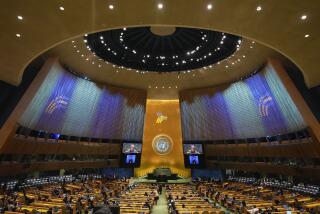An Arms-Control Script Waiting to Be Written
- Share via
Rancho Cielo, Dec. 24, 1986
In his televised talk to the nation last night, President Reagan again proved that he must be reckoned with. Liberals are struck dumb, conservatives can’t decide whether to be proud or angry, with the signing on live television of the integrated arms-control treaty of 1986.
With Soviet leader Mikhail S. Gorbachev at his side and their wives looking on, Reagan enjoyed the surprise sprung on an anxious world. “Nancy and I could think of no better present this holiday season than the one we share tonight with the American and Soviet peoples, with the entire world.”
The President’s boyish grin revealed an added pleasure. Just as he did at his first superpower summit in Geneva 13 months ago, Reagan has shown everyone, including his staff, that he can deal effectively with demanding foreign-policy questions.
Experts today are agreeing that the treaty signed by Reagan and Gorbachev represents major progress in U.S.-Soviet relations, and that it is a serious effort to reduce nuclear weapons rather than just limit them. The details have been reported elsewhere: reductions in missile launchers that include major constraints on Soviet weapons able to strike U.S. land-based missiles, a conditional extension of the anti-ballistic missile treaty until at least the year 2000, permission for extensive research on strategic defenses (“Star Wars”), and radical cuts, in stages, of Euromissiles. The last-named fulfills the leaders’ commitment at Geneva to work for an interim agreement on Soviet SS-20 and U.S. Pershing and cruise missiles.
To be sure, the basic framework of the treaty still must be developed. This creates a parallel with the meeting at Vladivostok in 1974 between Leonid I. Brezhnev and Gerald R. Ford. And the treaty’s remaining in force is contingent on the superpowers’ reaching further precise agreements, especially on the details of deep cuts in offensive nuclear weapons and the directions to be taken by strategic defenses. But enough has been agreed on to signal success and point the way forward.
Most remarkable, perhaps, is the way in which Reagan made this treaty possible, virtually under the noses of the naysayers who dominated the first part of his presidency. As late as July, Administration hard-liners, principally mid-level civilian officials at the Pentagon, were trying to box in the President by denouncing Soviet cheating on earlier treaties and any thought of compromising on Star Wars. Reagan permitted them the style and the rhetoric while stealing the substance.
In retrospect, the first major step was Gorbachev’s proposal in the late spring to trade deep cuts in offensive missiles for a 15- to 20-year extension of the ABM treaty. The reductions would meet Reagan’s most cherished goal; the extension would trammel Star Wars. As a further sweetener, Gorbachev reduced his demand for limits on the British and French forces.
For his part, Reagan agreed that the United States would attend a special meeting of the Standing Consultative Commission in Geneva, which would discuss the Soviets’ complaint that the United States was abrogating the SALT II treaty. Reagan also wrote a letter to Gorbachev suggesting “new ideas.” Conducted virtually in public, the drafting process indicated that the President was finally taking charge of the U.S. arms-control effort.
Reagan’s master stroke took a leaf from the book of Richard M. Nixon and Henry A. Kissinger. Beset by bureaucratic limits on his ability to act, Reagan created a special means to develop positions and test them with the Soviets. He asked one of his former national-security advisers to work quietly with a small bipartisan group of retired government specialists on Soviet relations and arms control, including some individuals purged early in the Reagan Administration.
Meanwhile, a long-time presidential confidant with strong ties to the Republican right wing made several secret trips to Moscow during the fall, while all eyes were on the efforts by Pentagon civilians to sidetrack progress. Notably, the State Department and the arms-control agency, denuded of most of their experts, played little part in the autumn’s intricate dealings. Nor did the Geneva arms talks figure significantly in U.S.-Soviet negotiations.
The agreement reached just in time for Christmas was less an inspiration of product than of process. It had long been clear that some trade-off was possible between deep cuts in offensive intercontinental nuclear weapons and limits on the deployment of Star Wars defenses. At issue were the terms and Reagan’s ability to preserve his hole card until he saw Gorbachev’s.
The President gained success through back-channel dealings that gave Gorbachev a significant cachet in Kremlin politics, and through the series of thresholds embodied in the treaty. Rather than open-ended American restraint in strategic defenses, preservation of the integrated arms-control treaty depends on the results of future negotiations. Each side has an incentive to make them work. Indeed, it cannot be ruled out that both sides will in time agree to some limited form of strategic defenses, while Reagan can claim that his ultimate vision, to make nuclear weapons “impotent and obsolete,” is preserved.
Looking back, Reagan succeeded by the skin of his teeth. As late as July, skeptics feared that he would not take personal command, assemble advisers committed to his goals or understand that arms control now is worth more than unproved Star Wars later. Nor was it clear that either he or Gorbachev would value agreement above propaganda directed at Western Europe. In the end, leadership was the key.
More to Read
Sign up for Essential California
The most important California stories and recommendations in your inbox every morning.
You may occasionally receive promotional content from the Los Angeles Times.













